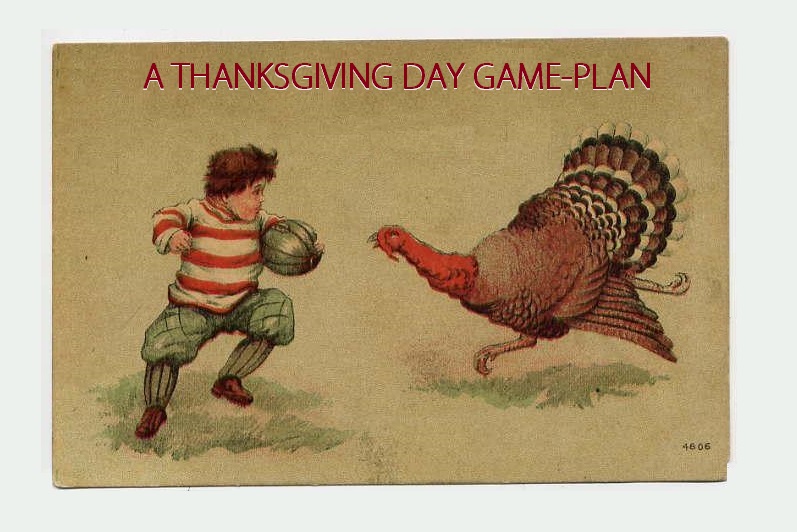Thanksgiving Day Game-Plan & Survival Guide
In normal times (that is, in the sorely-missed pre-covid-19 days, Thanksgiving brought to mind a whole host of things: enduring and ongoing traditions, gatherings of friends and family, often crazy traffic (typically, the most traveled holiday in these United States, after all) and — of course — food.
Especially food.
Lots of food. Not for nothing, the holiday is often nicknamed “Turkey Day.” And everyone faces this national, seasonal feast in his or her own, personal and unique way.
Some of us regard the holiday meal as if it were an “All You Can Eat Challenge” extravaganza.
Others mechanically pile their plates with lots of everything set before them, and then feel obligated to eat all they took.
Still others allow the eating and food issues they struggle with the rest of the year to spin wildly out of control on Thanksgiving.
In my practice as a Registered Dietitian and Nutrition Therapist, I have worked with quite a few clients who view the holidays with more than a bit of trepidation. Even outside of the consultation room, friends confess to me that they regard Thanksgiving dinner — and the many festive meals and parties in the holiday season that follows Thanksgiving — with a kind of grim resignation, having made peace with the likelihood that they will end up eating and drinking more than they really should, and then dearly regretting it later.
Another aspect of the holiday in the good old non-social distancing days was the series of ever-present football games on TVs across the country. And oddly enough, even as football coaches implement their game-plans, we Registered Dietitians and Nutrition Therapists have game-plans, too. But instead of guiding teams in sporting events, we guide people toward having Thanksgiving experiences that are satisfying for both body and soul. There’s an expression you hear quite a bit these days: “If you fail to plan, you plan to fail,” and that sentiment pretty well captures my advice about food and the holiday. So with that in mind, I’m pleased to share some helpful Thanksgiving Holiday strategies:
PREPARING FOR THE THANKSGIVING MEAL
Our first strategy revolves around pre-meal food choices. Thanksgiving tends to be chock full of what we think of as comfort food: mashed potatoes, candied yams, cranberry sauces, savory stuffings, pumpkin pies, thick gravies, and, well, you get the picture. Obviously, if you are planning the meal, you have the opportunity to prepare a menu that skews to the healthy side, but still includes a wide variety of options.
For instance, instead of cooking a whole turkey, consider preparing one or two full sized turkey breasts. Turkey breasts contain white meat and are lower in fat. Since white meat cooks at a lower temperature than dark meat anyway, with roasted turkey breasts your meat course can be slow-roasted to moist and juicy perfection (as opposed to a full cooked turkey that yields dry white meat and moist dark meat,) and a ton of delicious turkey breast recipes are just a Google search away. Likewise, select starch course recipes that call for less sugar — yams are plenty sweet on their own — and utilize more whole grains for stuffings, like brown or wild rice, or savory quinoa. Incorporating high fiber vegetables and grains will satisfy your appetite in a tasty, healthful way.
If you are a guest at someone else’s table (and so have no control over what is to be served,) bring a healthy, generously stocked serving dish of your own. Not only can you share your dish with your fellow diners, you can be sure that you have at least one healthy item to build your meal around. For instance, a hearty raw veggie salad with a light vinaigrette dressing, sprinkled with toasted pumpkin seeds (perhaps harvested from your Halloween jack o’ lantern pumpkins) would be seasonably appropriate. Then you can add to your own plate small tasting servings from the rest of the table.
THE DAY OF THE THANKSGIVING MEAL
I always recommend that on Thanksgiving Day my clients have the kinds of breakfasts and lunches they would normally eat on any other day, and not abstain from eating “to make room for” the big meal. If we sit down at the table super-hungry, we tend to eat ravenously and quickly, taking in more food than we need to before our bodies have the chance to signal that we are full. Slow eating is a critical must here…it actually takes about 20 minutes for the brain to get the “stop eating, tummy is full” signal from the stomach. A tip I often share: One way to slow your eating is to chew each bite well, savoring the flavor and use all of your senses in the process.
Moreover, the very idea of eating until very full is actually problematic. It is much healthier, all evidence suggests, to eat to the point of feeling “no longer hungry” instead of achieving complete fullness. And if you finish your meal groaning and loosening your belt… you’ve probably eaten too much!
Other Holiday Game-Plan strategies have to do with your own attitude and behavior. Before the meal you might remind yourself of the times in the past you’ve eaten to excess and felt uncomfortable, and conversely think about times you had not over-eaten and felt grateful about that choice. Commit to the same positive results for the meal you are about to have.
Gratitude, of course, plays a big part of Thanksgiving, and can be part of your Holiday Game-Plan strategy. Decide to keep your focus on the event — more on why you are celebrating the holiday, and less on the food. Try listing at least three things you’re thankful for before you even take a seat at the table.
AT THE THANKSGIVING TABLE
When you do take a seat at the table, select a chair as comfortable as possible. Sit where you have a nice view, and choose a spot that puts you with pleasant and positive people as dining companions. Don’t, for instance, sit next to Aunt Agatha who always nags you about getting married, or next to Uncle Eddie who will angrily rant about politics all meal long. And if your dining companions consist solely of nagging, ranting relatives, consider finding a place at the kids’ table.
Sometimes dinner companions — well-meaning or not — make comments and observations about what or how much other people eat or don’t eat, or about body size and physical appearance. People at the receiving end of these remarks can feel upset, or judged, or triggered by what is said to them, especially if they are working through eating or body issues. If you fall into this category, I recommend that as part of your game-plan, you take preemptive action by letting people know that their feedback reflecting anything about you and your eating choices are unwelcome. Also unwelcome might be any comments about your physical appearance (even comments they mean to be taken as compliments.)
Some people can’t help themselves, and may continue to offer unwanted advice and observations, even when asked not to. If anyone crosses such boundaries, it is perfectly fine to speak up when others butt in:
- Thank you for sharing.
- I get to choose what I eat
- What I eat is something that I get to decide
- It works better for me when I make my own food choices
- You don’t get to go there
- You’re not trying to manage what I eat, are you?
- It’s my job to manage my intake
ONCE THE MEAL BEGINS
As you prepare to eat, take a moment to become fully present. Use all your senses; be aware of the smells, sights, noises around you. Bring this same way of being aware to the food as you start to eat. This kind of grounded presence will make the food more enjoyable and you will automatically eat slower.
As you prepare to eat, you might also think about at least three goals you’re hoping to achieve during the meal. These goals can be about your food intake, (i.e. drink three glasses of water, finish when no longer hungry, etc.) or about connecting with others around you (i.e. have a meaningful conversation with Cousin Hank, get to know a new face at the table, etc.)
Another strategy to avoid eating more than you’d prefer is to come up with a way to track how your body responds to what you are eating. You might evaluate your level of hunger on a scale of one to ten and plan to stop when you reach seven. Another similar approach is to imagine a “Hunger Highway Traffic Light” (green means hungry, yellow means not quite so hungry, and red means hunger is satisfied.) You might plan to slow down at yellow, and stop at red.
If possible, see if you can get a fellow diner to be your “eating buddy” and the two of you can encourage each other’s consumption goals. During the meal each of you can remind the other to check in and assess hunger numbers and fullness levels. You can also share support through mutual coaching to insure that both of you eat your meal slowly, taking time to enjoy your dinner.
Of course, the rubber meets the road when the food meets the plate. If possible, using a smaller plate can be helpful.. A recent study suggests that people will eat more when food is offered on a larger plate. But no matter what size your plate is, don’t pile food on to it. Realize that a mouthful of something yummy is just as satisfying as a mound of it.
Here’s a helpful strategy I recommend to my clients: Divide your plate into thirds, with each third dedicated to a type of the range of foods offered. One third of the plate can be set aside for your protein, while another third is dedicated to the assortment of small serving samples of all the carbs that catch your fancy, and the last third for the various veggie dishes. Sauces and dressing are best taken in small amounts on the side, and then drizzled on sparingly. You’ll find that a plate offering tastes of lots of different foods will be thoroughly satisfying — after all, the first taste is often the most satisfying.
Your dessert plate can work similarly. This small plate can be divided in half; consisting of fruit apportioned on one half, and small tasting samples of the other treats making up the other half.
As a final strategy, think of something with which to reward yourself — a non-food reward, naturally! — if you are able to leave the table comfortably satisfied and not over-full. Decide what this reward will be (ok, feel free to consider it a self-bribe) before the meal begins. That way you can have something to look forward to, in addition to the good feeling you’ll achieve as you acknowledge how well you demonstrated your own commitment to yourself.
A FINAL THOUGHT
Finally, if we and those we love are able to walk away from the Thanksgiving meal without over-eating, we are also setting the stage for another Thanksgiving seasonal tradition: more leftovers!





